 USA – Armoured Cruiser 1888-1898
USA – Armoured Cruiser 1888-1898WW1 US Battleships:
USS Maine | USS Texas | Indiana class | USS Iowa | Kearsage class | Illinois class | Maine class | Virginia class | Connecticut class | Mississippi class | South Carolina class | Delaware class | Florida class | Arkansas class | New York class | Nevada class | Pennsylvania class | New Mexico class | Tennessee class | Colorado class | South Dakota class | Lexington class
The first Atlanta class cruisers (some says Boston class) were a pair of protected cruisers, and among the very first steel warships of the “New Navy” in the 1880s. They differed in some ways so other authors have them separated, but in truth they were very close sisters so we will have them treated both here. Their main goal was to fast deploy to any point of the coast threatened by an enemy formation and kept them at beay with heavy guns. Speed and artillery strenght were more important than protection. USS Atlanta was laid down on 8 November 1883 at Chester in Pennsylvania, at the Delaware River Iron Ship Building and Engine Works and commissioned at the New York Navy Yard on 19 July 1886. USS Boston was laid down on 15 November 1883 at the same, launched later on 4 December 1884, and commissioned on 2 May 1887 at New York Navy Yard. She had a longer career, still used as TS in 1916 abnd converted as a receiving ship, ending her career in 1946 as USS IX-2 at Yerba Bueno Island, used for radio training. #ussatlanta #ussboston #usnavy #USN #protectcruiser #newnavy
Development
The “old navy” is the term used prior to the 1890s to describe the collection of vessels inherited from the 1860s civil war and few new constructions. The congress had little interest indeed to build a powerful navy, and until 1883, it was limited to an eclectic lot of sometimes strange vessels and classic steam frigates: The closest thing to cruisers were the Wampanoag class of 1864, designed to intercept Confederate raiders and for a possible commerce raiding against great powers in case of war. There still also about twenty or so monitors, iron built. But apart these, no modern cruiser, steel made.
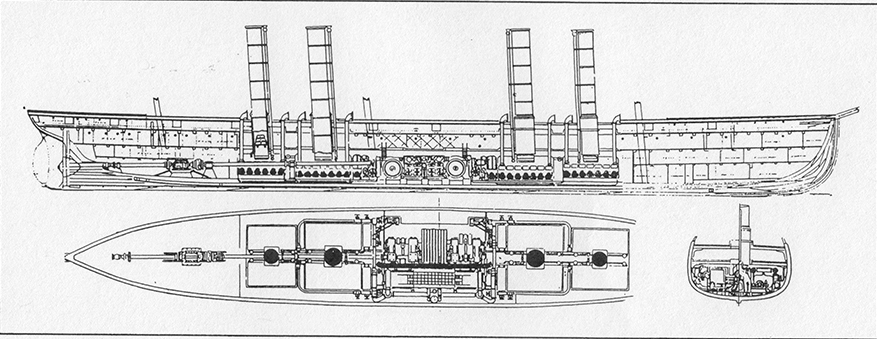
The last “cruisers” in US inventory, the wooden-built Chattanooga class steamers (1864)
Things in South America however advanced quickly and at the end of the 1870s and early 1880s, Brazil, then Argentina and Chile started a naval arms race. Powerful new ships entered the fray. Not to be undone on its southern “backyard” under the Monroe doctrine, the USN pressed the congress to authorized a few new modern ships able to at least practice a commerce war as retaliation against any naval power.
Thus was born the idea of building four new ships, all made of steel, at the only yard capable of building them at the time, Delaware River Iron Ship Building and Engine Works, which freshly acquired the latest foundry process from Europe to be able to manage large structures.
Four ships were ordered there as eventually authorized by the congress in 1883, called “ABCD” diven their names. Apart the two Atlant class were are about to see, which had heavy guns usable as deterrent, USS Chicago was a very different animal and pure commerce raiding ship armed with smaller guns. USS despactch was a scout for this heteroclytous fleet and the fastest ship the US Navy ever had, all steam powered unlike the three cruisers.
USS Atlanta was thus ordered as part of the “ABCD” ships, with her sister Boston as well as USS Chicago and the dispatch vessel Dolphin, all ordered from John Roach & Sons of Chester, Pennsylvania. Secretary of the Navy William C. Whitney refused to accept Dolphin as defective, and the Roach yard went bankrupt. USS Atlanta was towed to be completed at New York Navy Yard and with little experience in steel-hulled ships it took far more time than expected.
Design of the class
Hull and general design
USS Atlanta and Boston, were built on similar plans, they were relatively low-freeboard ships with both steam and sail, heavily armed, with a mix of 8-inches and 6-inches, all modern rifled breeched loaded guns placed on traverse railings and with masks. Engineers designed on a 3,189 long tons (3,240 t) displacement two vessels just 283 ft (86.3 m) long but 42 ft (12.8 m) wide, so giving a relativey good lenght-beam ratio of 9.4/1 for a cruiser, and based on an important draft of 17 ft (5.2 m) for stability, which made them purely sea-going vessels, albeit the low freeboard was only suitable along the shoreline and coastal waters.
They had a low silhouette woth a central casemate which ended with a small bridge behind the foremast, and a conning tower above the forward barbette, offset to port.
What was remarquabe about them was their main artillery placed in echelon, both offset to the axis port and starboard, fore and aft. This configuration started to be wildely used in the later 1870 and 1880s in Europe on capital ships and turret armed vessels. Apart this they had two tall funnels close apart and two moderately tall mast of same height and three-squared, the mainmast havng a spanker for agility under sail. There were no bowsprit so the jibs were attached to the tip of the prow.
The prow ended with a bulwark to protect the deck in heavy weather, quite richly ornamented.
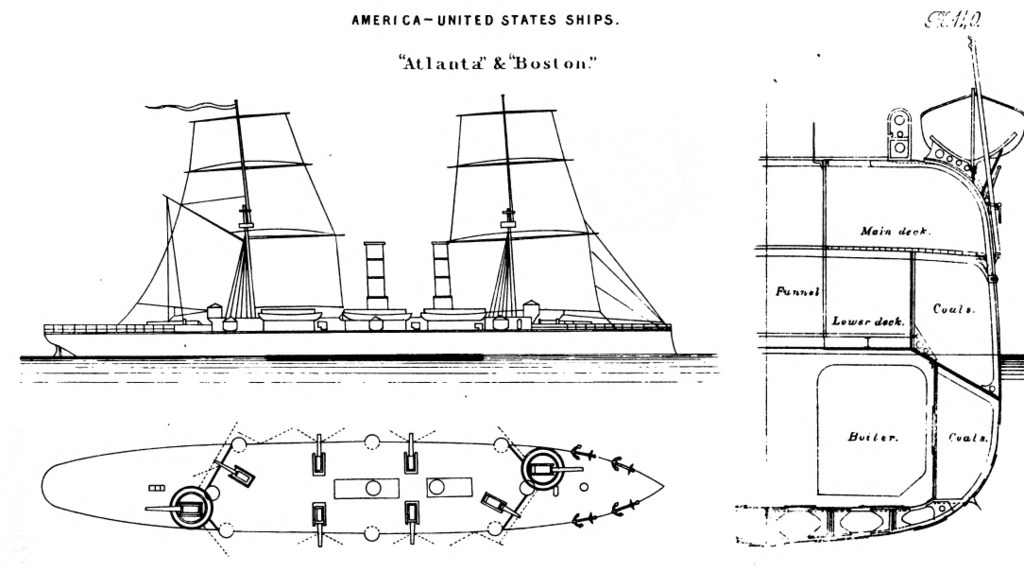
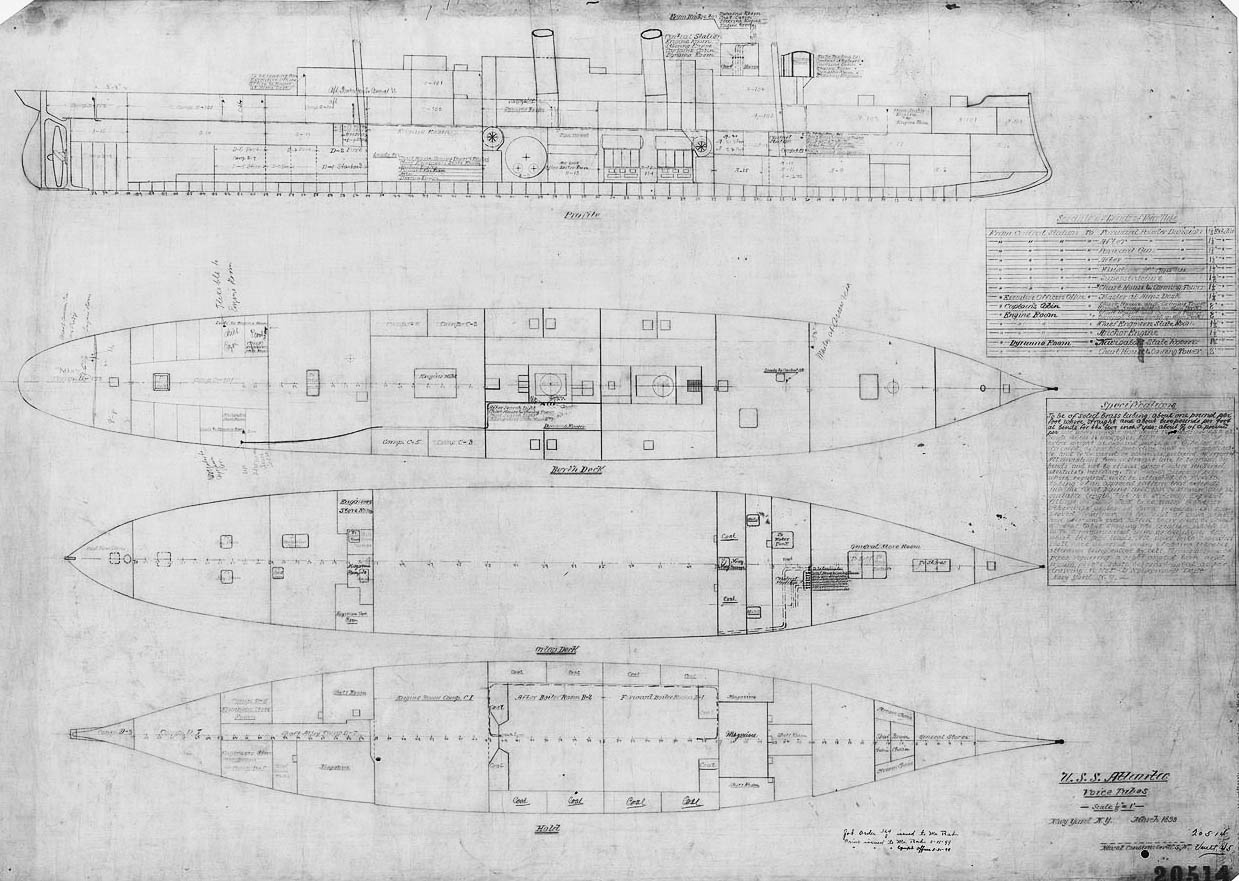
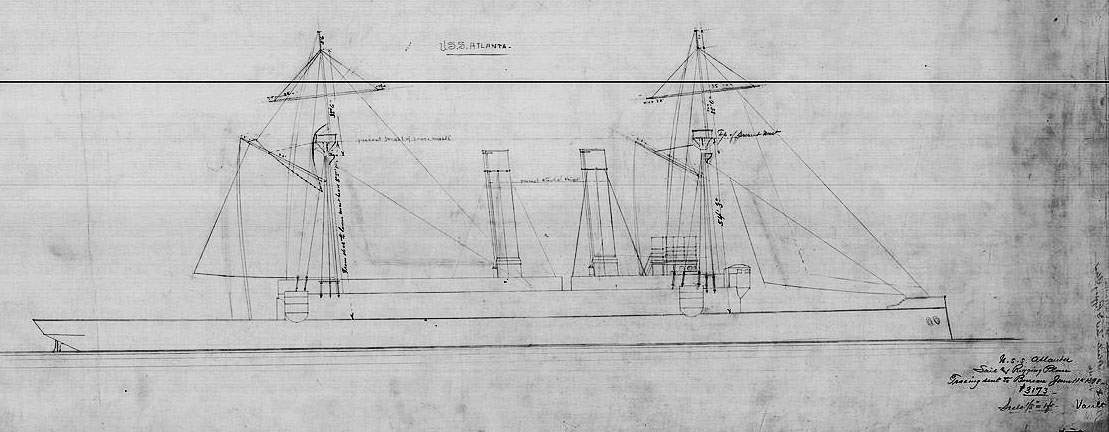
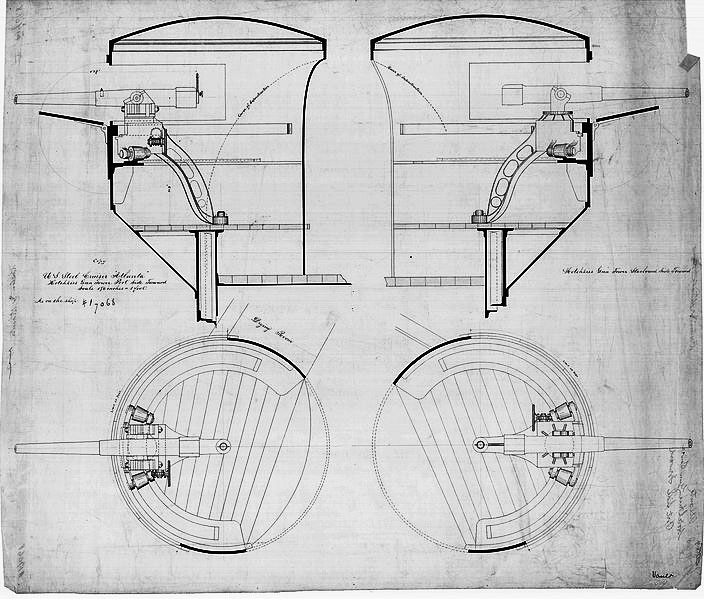
Both ships had partial electric lighting in the citadel, brand new at the time, and squared portholes fore and aft, and in the casemate which was partially open in the middle of the ship. Plans also show that deck planking was only maintained on the amidship section and all-metal on the fore and aft decks.
They had also two anchors resting on berths port and starboard, and two gooseneck cranes to manage them, a capstan, but no wave breaker. The stern was clipper-like, rounded, with single tall and narrow half moon rudder and large four bladed brone propeller for a steam engine working at low revolutions.
Protection
Armor protection was light overall: There were 2-inch (50.8 mm) over the gun shields and over the conning tower, 1.5-inch (38.1 mm) on the armored deck which extended 100 feet (30 m) over the machinery spaces. No armour belt, no proper citadel as there was no bulkheads, and no ASW compartimentation.
Powerplant
In 1897–1899 USS Atlanta received her triple-expansion steam engine, of a relatively new design at the time, rated for 4,030 ihp (3,010 kW) and as-built it included also eight coal-fired cylindrical fire-tube boilers. They produced 100 psi (690 kPa) steam. The original single horizontal compound engine produced 3,500 ihp (2,600 kW) on the single shaft, making for a top speed of 16.3 knots (18.8 mph; 30.2 km/h) on trials, and 13 knots (15 mph; 24 km/h) as designed, which ws quite impressive. However in heavy weather, they rolled and pitched heavily and ploughed a lot due to the low freeboard.
Atlanta and Boston, like USS Chicago received a full sail rig to extend their cruising range, removed before 1900. As said above, these were two masts, without bowsprit. USS Chicago had it more elaborate, with a three masted barque configuration. Theey carried up to 490 tons of coal, making for a calculated rabge of 3,390 nmi (6,280 km; 3,900 mi) at 10 knots (19 km/h; 12 mph).
Armament
As-built, it comprised two 8-inch (203 mm)/30 Mark 1 guns, and six 6-inch (152 mm)/30 caliber Mark 2 guns as main and secondary armament.
It was completed by two 6-pounder (57 mm (2.24 in)) rapid fire guns for incoming threats like spare-torpedo cutters popular at the time (ancestors of torpedo boats), and two 3-pounder (47 mm (1.85 in)) Hotchkiss revolving cannon for close range completed bt two 1-pounder (37 mm (1.46 in)) Hotchkiss revolving cannon, and two .45 caliber (11.4 mm) Gatling guns, rounding this up. The latter could be mated on wheeled carriages to support landing parties. The 8-inch guns were were placed in open barbettes, subjected to shrapnel and they were later covered by partial gun shields.
Main

The 8-in guns Mark I were 30 caliber guns
⚙ specifications 8-inch/30-caliber gun |
|
| Weight | 29,100 lb (13,200 kg) (without breech) |
| Barrel lenght | 257.99 in (6,553 mm) Mark 1 Mod 0/240 in (6,100 mm) bore (30 calibers) |
| Elevation/Traverse | −5° to +20°, −150° to +150° |
| Loading system | |
| Muzzle velocity | 2,000 ft/s (610 m/s) |
| Range | 14,000 yd (13,000 m) at 20° elevation |
| Crew | |
| Round | 260 lb (120 kg) 203 mm |
| Rate of Fire | 0.5–1 round per minute |

Secondary: Mak 2 6-inches/30 (152 mm)

They were the primary battery for USS Dolphin, secondary batteriesfor Atlanta, Chicago, and Boston, Mark 3 being used on following early protected cruisers and the capital ships USS Maine and Texas. They were placed under the walls of the casemate amidship, 193.53 in (4,916 mm) in lenght, 180 in (4,600 mm) bore (30 calibers), firing a 105 lb (48 kg) naval armor-piercing shell 0.66 rounds per minute (bag guns). The 6-inch guns were converted to rapid firing with brass case ammunition replacing powder bags later in the 1890s, for 1.5 rpm. 9,000 yd (8,200 m) at 15.3° elevation for the range.
Tertiary
-Two 6-pounder (57 mm (2.24 in)): Rapid fire guns, they were placed in semi-enclosed barbettes, sponsons amiships, with the larger 6-in guns around.
-Two 3-pounder (47 mm (1.85 in)): Hotchkiss revolving cannons. Unsure location
-Two 1-pounder (37 mm (1.46 in)): Hotchkiss revolving cannons. Unsure location
-Two .45 caliber (11.4 mm) Gatling guns typical of the pattern developed in 1863 with gradual improvements up to 1883. These were an up-scaling of the original civil war model, using larger rounds. They were placed in corner turrets on the casemate angles.
⚙ specifications |
|
| Displacement | 3,189 long tons (3,240 t) |
| Dimensions | 283 ft x 42 ft 2 in x 17 ft (86.26 x 12.85 x 5.18 m) |
| Propulsion | 1 shaft horizontal compound engine, 8× boilers 3,500 ihp (2,600 kW), Sails |
| Speed | 16.3 kn on trials, 13 kn as designed |
| Range | 3,390 nmi (6,280 km; 3,900 mi) at 10 kn (19 km/h; 12 mph) |
| Armament | 2× 8-in/30 Mk 1, 6× 6-in/30 Mk, 2× 6-pdr, 2× 3-pdr, 2× 1-pdr, 2× .45 cal. Gatling |
| Protection | Barbettes 2 in (51 mm), Deck 1.5 in (38 mm), CT 2 in (51 mm) |
| Crew | 284 |
 USS Atlanta
USS Atlanta
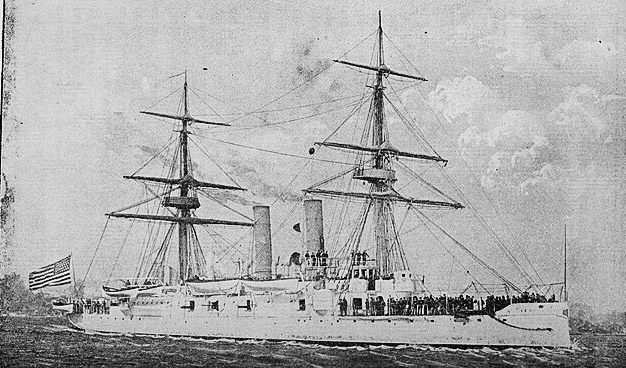
USS Atlanta was at New York fitting out until July 1887, after which she was accepted in the North Atlantic Squadron. For two years, she cruised along the Atlantic coast, from Newfoundland down to the Gulf of Mexico and West Indies. On 30 September 1889, she joined the “Squadron of Evolution” bound to Europe and Mediterranean in winter. While back she sailed to Brazil and was back to New York by late July 1890.
She resumed duty along the east coast and West Indies and by February-April 1891, she operated in the Gulf of Mexico. By May–October she was on the Atlantic coast for exercises of Boston and New York, with the Naval Militia. October 1891 to July 1892 was a repeat on the same locations, as well as Central/South American coastal areas.
On 2 September 1892, she was back with the North Atlantic Squadron. From December 1892 to February 1893, she was in the West Indies. In March–May 1893 she took part in the Naval Review at Hampton Roads. In May–June she was back in the Gulf of Mexico. On 18 July 1893 she was decommissioned at Norfolk until 2 April 1894. She was back in the Atlantic for 17 months. As paft of her actions she landed a party ashore at Boca del Toro in Colombia on 8 March 1895 to protect US interests and citozens (Liberal Party revolt, filibusters). In September 1895, she was decommissioned again ay NY Yard for five years.
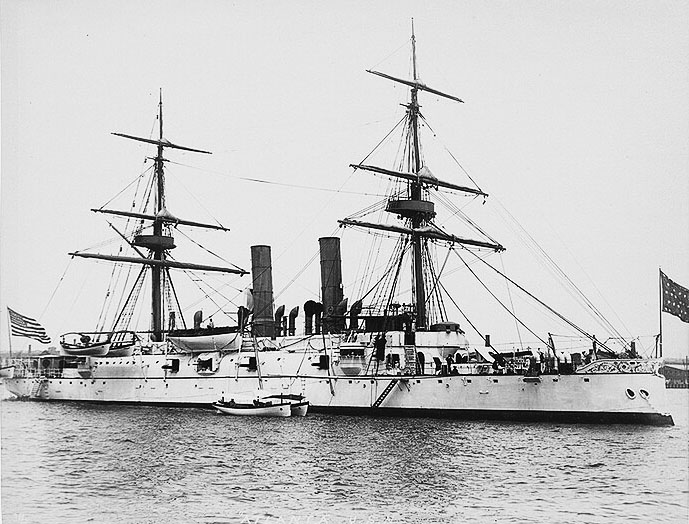
On 15 September 1900 she was recom. with Cdr. E. C. Pendleton in command and in October, she joined the South Atlantic Squadron off Brazil until November 1902 and was reassigned to the Caribbean Squadron. She landed more parties as Santo Domingo in April 1903, Porto Bello (Panama) in December. In 1904 she was a Mediterranean cruise and back in October via the western coast of Africa and Cape Town, to the South Atlantic station and in Hampton Roads on 26 December. She was sent to reserve in Annapolis on 12 January 1905, until 8 May, and reassigned to the Coast Squadron to to train midshipmen. In November 1905, too old for active service, she was sent to Norfolk and converted as a barracks ship for sailors of the Torpedo Flotilla, until 1909, later in Charleston and onn 23 March 1912 she was decommisioned, stricken on 24 April, sold at Charleston on 10 June for scrap.
 USS Boston
USS Boston
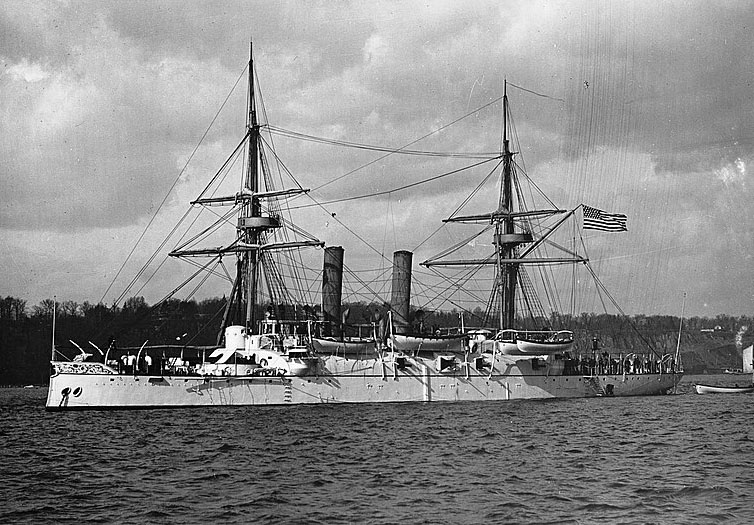
USS Boston was completed later than her sister and commissioned in 1888. She made her shakedown cruise to Guatemala and Haiti to protect US citizens and interests, and joined the Squadron of Evolution on 30 September 1889. She made a Mediterranean cruise, back to South America (7 December 1889 to 29 July 1890) and east coast in 1891. She departed New York on 24 October 1891 and sailed southwards to the Cape Horn, and northwards in the Pacific to San Francisco, arriving on 2 May 1892. She cruised to Hawaii from 11 August 1892 to 10 October 1893 and landed there a shore party in January 1893 to overthrow the Hawaiian monarchy. She was on the West Coast until laid up at Mare Island Navy Yard, 4 November 1893.
Recomm. 15 November 1895, she was assigned to the Asiatic Squadron based in Yokohama on 25 February 1896. She staye don station for four years. In the Spanish–American War she took part in the Battle of Manila Bay on 1 May 1898, landing ashore a party to capture Manila on 13 August. From 4 October to 23 December she was sent to Taku in China to safeguard US interests after the coup d’etat by the Empress Dowager Cixi. She was back in the Philippines for the pacification until 8 June 1899, having at that time her rig removed as shown by a photo of 1899 in the Philippines.
USS Boston was back to San Francisco for maintenance, decom. on 9 August 1899 at Mare Island Navy Yard from 15 September until 11 August 1902. She resumed Pacific Squadron activities and on 7 November 1903, she was the first off Panama to support it’s independence preliminary to the seizure of the Panama Canal. From 16 to 25 June 1905 she was at the Lewis and Clark Centennial Exposition at Portland. From 23 April to 10 May 1906 she cared for the victims of the San Francisco earthquake. In April 1907 she transported the Honduran peace delegation to end the Honduran–Nicaraguan War. She was decommissioned in Puget Sound Navy Yard on 10 June 1907 and was a training ship for the militia from 15 June 1911 to September 1916, so seeing WW1 and surviving her sister.
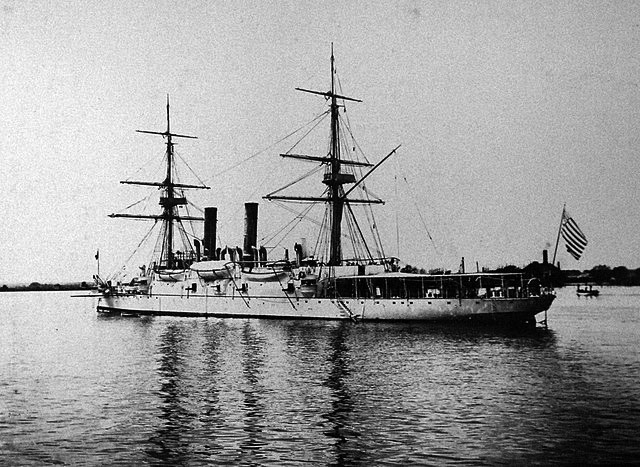
With the US at war from April 1917, USS Boston was loaned to the US Shipping Board from 24 May 1917 and until June 1918, converted as freighter by the Seattle Construction & Drydock in 1917–1918. She received a massive structure above her original hull, completely disarmed. By 18 June 1918, she was recommissioned at Mare Island Navy Yard as receiving ship, towed to Yerba Buena Island in California and served under this quality until 1940. She was renamed USS Despatch to free the name for a new heavy cruiser by 9 August 1940, and until October 1945, became the USN radio school, under the new name IX-2 from 17 February 1941. After the war she was towed to sea and sunk as artificial reef off San Francisco on 7 April 1946.
Both main guns were moved to the Seattle Naval Hospital in 1942 and after it closed, to the new Firlands Sanitarium, King County from 1947. Post-1952, they were in Hamlin Park, Shoreline, Washington. One had a plaque on the Battle of Manila Bay.

USS Despatch/IX-2 radio school ship at Yerba Buena Island after WW2.
Read More/Src
Books
Bauer, K. Jack; Roberts, Stephen S. (1991). Register of Ships of the U.S. Navy, 1775–1990: Major Combatants. Greenwood Press.
Friedman, Norman (1984). U.S. Cruisers: An Illustrated Design History. Annapolis, Maryland NIP
Gardiner, Robert; Chesneau, Roger (1979). Conway’s All the World’s Fighting Ships 1860–1905.
Gibbons, Tony (2007). The Encyclopedia of Ships. London: Amber Books Ltd.
Rentfrow, James C. Home Squadron: The U.S. Navy on the North Atlantic Station. Annapolis, Maryland: NIP
Spears, John Randolph. A History of the United States Navy. New York: C. Scribner’s Sons, 1908.8
The White Squadron. Toledo, Ohio: Woolson Spice Co., 1891.25
The White Squadron: Armed Cruisers, U.S.N. New York: International Art Publ. Co, 1800.
The White Squadron of the U S Navy. New York: James Clarke Publisher, 1894.
Bauer, K. Jack; Roberts, Stephen S. (1991). Register of Ships of the U.S. Navy, 1775–1990: Major Combatants. Greenwood Press.
Burr, Lawrence. US Cruisers 1883–1904: The Birth of the Steel Navy. Oxford: Osprey, 2008.
Friedman, Norman (1984). U.S. Cruisers: An Illustrated Design History. NIP.
Gardiner, Robert; Chesneau, Roger (1979). Conway’s All the World’s Fighting Ships 1860–1905. New York: Mayflower Books.
Gibbons, Tony (2007). The Encyclopedia of Ships. London: Amber Books Ltd.
Rentfrow, James C. Home Squadron: The U.S. Navy on the North Atlantic Station. NIP
Spears, John Randolph. A History of the United States Navy. New York: C. Scribner’s Sons, 1908.
The White Squadron. Toledo, Ohio: Woolson Spice Co., 1891.
The White Squadron: Armed Cruisers, U.S.N. New York: International Art Publ. Co, 1800.
The White Squadron of the U S Navy. New York: James Clarke Publisher, 1894.
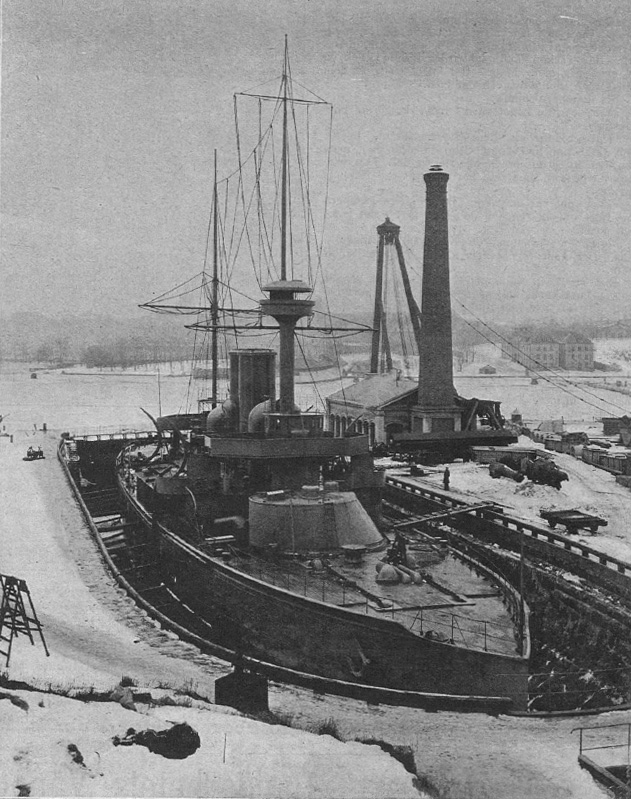

Links
en.wikipedia.org USS_Boston_(1884)
navsource.org atlanta.htm
history.navy.mil/ atlanta-protected-cruiser-ii
navweaps.com/ 6-in /30_mk1
navweaps.com 8-in /30_mk1
navsource.org/ boston.htm
history.navy.mil/c uss+boston%22+1887-1946
spanamwar.com/boston.htm
navsource.org boston.htm
commons.wikimedia.org/ USS_Boston
Videos
Model Kits
USS Boston 1898 Iron Shipwrights 1:350
USS Atlanta – 1886 Combrig 1:700
USS Boston – 1887 Combrig 1:700

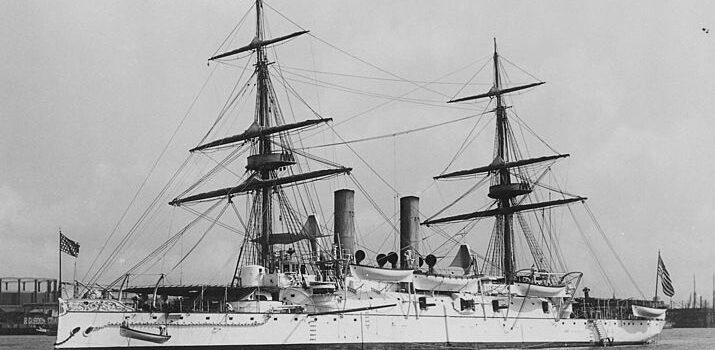
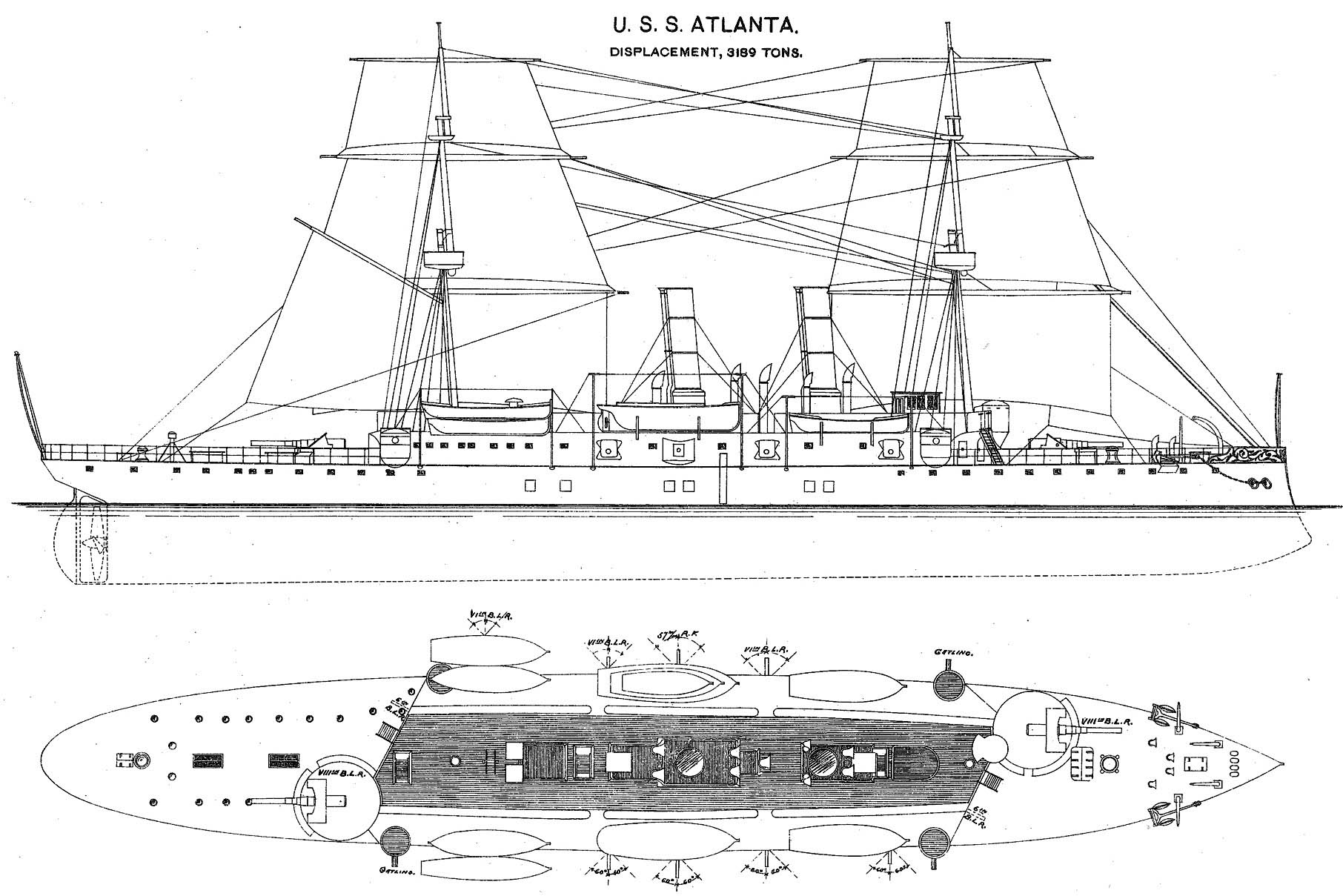
 Latest Facebook Entry -
Latest Facebook Entry -  X(Tweeter) Naval Encyclopedia's deck archive
X(Tweeter) Naval Encyclopedia's deck archive Instagram (@navalencyc)
Instagram (@navalencyc)





 French Navy
French Navy Royal Navy
Royal Navy Russian Navy
Russian Navy Armada Espanola
Armada Espanola Austrian Navy
Austrian Navy K.u.K. Kriegsmarine
K.u.K. Kriegsmarine Dansk Marine
Dansk Marine Nautiko Hellenon
Nautiko Hellenon Koninklije Marine 1870
Koninklije Marine 1870 Marinha do Brasil
Marinha do Brasil Osmanlı Donanması
Osmanlı Donanması Marina Do Peru
Marina Do Peru Marinha do Portugal
Marinha do Portugal Regia Marina 1870
Regia Marina 1870 Nihhon Kaigun 1870
Nihhon Kaigun 1870 Preußische Marine 1870
Preußische Marine 1870 Russkiy Flot 1870
Russkiy Flot 1870 Svenska marinen
Svenska marinen Søværnet
Søværnet Union Navy
Union Navy Confederate Navy
Confederate Navy Armada de Argentina
Armada de Argentina Imperial Chinese Navy
Imperial Chinese Navy Marinha do Portugal
Marinha do Portugal Mexico
Mexico Kaiserliche Marine
Kaiserliche Marine 1898 US Navy
1898 US Navy Sovietskiy Flot
Sovietskiy Flot Royal Canadian Navy
Royal Canadian Navy Royal Australian Navy
Royal Australian Navy RNZN Fleet
RNZN Fleet Chinese Navy 1937
Chinese Navy 1937 Kriegsmarine
Kriegsmarine Chilean Navy
Chilean Navy Danish Navy
Danish Navy Finnish Navy
Finnish Navy Hellenic Navy
Hellenic Navy Polish Navy
Polish Navy Romanian Navy
Romanian Navy Turkish Navy
Turkish Navy Royal Yugoslav Navy
Royal Yugoslav Navy Royal Thai Navy
Royal Thai Navy Minor Navies
Minor Navies Albania
Albania Austria
Austria Belgium
Belgium Columbia
Columbia Costa Rica
Costa Rica Cuba
Cuba Czechoslovakia
Czechoslovakia Dominican Republic
Dominican Republic Haiti
Haiti Hungary
Hungary Honduras
Honduras Estonia
Estonia Iceland
Iceland Eire
Eire Equador
Equador Iran
Iran Iraq
Iraq Latvia
Latvia Liberia
Liberia Lithuania
Lithuania Mandchukuo
Mandchukuo Morocco
Morocco Nicaragua
Nicaragua Persia
Persia San Salvador
San Salvador Sarawak
Sarawak Uruguay
Uruguay Venezuela
Venezuela Zanzibar
Zanzibar Warsaw Pact Navies
Warsaw Pact Navies Bulgaria
Bulgaria Hungary
Hungary

 Bundesmarine
Bundesmarine Dutch Navy
Dutch Navy Hellenic Navy
Hellenic Navy Marina Militare
Marina Militare Yugoslav Navy
Yugoslav Navy Chinese Navy
Chinese Navy Indian Navy
Indian Navy Indonesian Navy
Indonesian Navy JMSDF
JMSDF North Korean Navy
North Korean Navy Pakistani Navy
Pakistani Navy Philippines Navy
Philippines Navy ROKN
ROKN Rep. of Singapore Navy
Rep. of Singapore Navy Taiwanese Navy
Taiwanese Navy IDF Navy
IDF Navy Saudi Navy
Saudi Navy Royal New Zealand Navy
Royal New Zealand Navy Egyptian Navy
Egyptian Navy South African Navy
South African Navy






























 Ukrainian Navy
Ukrainian Navy dbodesign
dbodesign